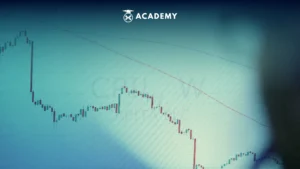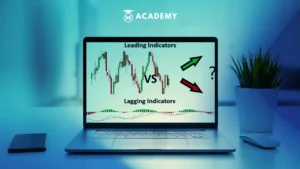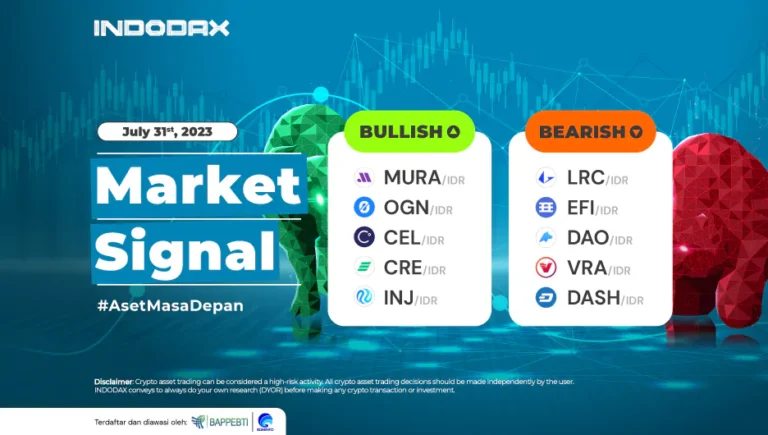In carrying out technical analysis, traders, including crypto investors, often use a type of indicator called lagging and leading indicators.
The lagging and leading indicators are types of indicators that can supply information based on time as a way to respond to price movements.
In addition, knowledge of these two types of indicators will help investors better interpret what is happening in the market.
What Are Technical Indicators in Crypto Trading?
To find out what lagging is and how it differs from leading indicators in analyzing investments, both stocks, and crypto, see the following reviews regarding leading and lagging indicators.

The definition of a lagging indicator is an indicator used to predict/confirm current prices/trends by utilizing historical data.
Lagging indicators rely on previous price movements to supply information about what is happening in the market.
As for this type of indicator, usually, in terms of movement, it will lag behind the price movement of an asset.
Later, traders will receive information and signals from past movements and must indicate what will happen next.
Meanwhile, a leading indicator is a type of indicator to make predictions about the direction of price movements or trends of an asset in the future.
Traders can later enter a trend earlier and estimate the exit point by using leading indicators.
In crypto trading, traders use lagging indicators to see trends in the price movements of an asset.
Thus, traders will get insight into the possible direction of the next price movement.
Meanwhile, with its use to develop trading strategies, leading indicators are often the choice of traders.
In this type of leading indicator, price movements will often be used as a comparison.
In this indicator, when the price of an asset decreases, the indicator goes up first.
This can happen because this indicator provides predictions of asset price movements.
Lagging as an Indicator in Crypto Trading
Several examples of lagging indicators include moving averages and Bollinger Bands. The following is an explanation of each, namely:
1. Moving Averages
Moving averages are included in the lagging indicator category because this indicator is the average price movement historically.
Moving averages can be used to identify a trend.
For example, when the price declines and reverses upwards, the moving average may increase higher than the price movement.
2. Bollinger Bands
Bollinger bands are also another example of a lagging indicator.
Bollinger bands are an indicator based on the level of volatility.
This one indicator will utilize moving averages that function as upper, middle, or lower bands when identifying whether prices are relatively higher or lower.
Therefore, this indicator can lag when these Bollinger bands react after price movements.
How to use lagging as an indicator for crypto trading basically by utilizing the two examples of indicators above, namely the Moving Average and Bollinger Bands.
For example, crypto traders can identify an ongoing trend with Moving Averages.
Meanwhile, if you take advantage of Bollinger Bands, traders can identify whether prices are relatively higher or lower.
On the other hand, in using lagging as an indicator, some advantages and disadvantages need to be known.
The advantage of the lagging indicator is that the signal is quite accurate.
In this case, traders will gain confidence to enter the market due to the confirmation it makes on the final prices.
Apart from that, by utilizing this lagging indicator, traders can also reduce the impact of false breakouts or the risk of failure that is often present.
Meanwhile, the drawback lies in the inability of lagging indicators to absorb new trends.
For example, when a reversal occurs on asset price movements, the lagging indicator’s signal will signal that the reversal is not just about to happen but has already happened.
As a result, traders may need to catch up to get profits or hold losses.
Leading Indicator in Crypto Trading
Some examples of leading indicators are the Relative Strength Index (RSI), Stochastic, and Moving Average Convergence Divergence (MACD). The following is an explanation of each, namely:
1. Relative Strength Index (RSI)
RSI is included in the leading indicator category because the same indicator this one can show changes in momentum in the market that have yet to be seen in price movements.
For example, the RSI Divergence indicates that the current trend has lost momentum and has the potential for a trend reversal.
Related to that, it can be seen as a signal that the price will fall by traders.
2. Stochastics
Stochastic is a leading indicator traders often use to analyze market conditions and crypto price trends.
The way it works is by comparing the level of an asset’s closing price at a certain price range within a certain period.
3. MACD (Moving Average Convergence Divergence)
Third, the MACD indicator is also categorized as a leading indicator in technical analysis.
This indicator is based on the Moving Average principle and acts as a trend-following indicator.
How to use leading indicators for crypto trading can be seen from the examples.
For example, on the RSI indicator, crypto traders can see changes in momentum in the market even though they are not yet visible in price movements.
Meanwhile, traders can analyze market conditions and current crypto price trends on the Stochastic type.
The use of leading indicators also has several advantages and disadvantages.
The advantages can be seen in its predictive and fast nature so that leading indicators can also help traders to enter potential trades at the start of a movement.
If you do this, the potential profit will be greater when asset prices align with the predicted results.
On the other hand, the drawback is that this type of indicator will have more disruptions or false signals.
Therefore, when compared with lagging indicators, leading indicators usually have poor accuracy.
What’s more, the signals on this indicator precede stock price movements, so it will make traders react too quickly.
This leading indicator will undoubtedly be much riskier for traders who need to be more careful when reading its signals.
Difference between Lagging and Leading Indicators in Crypto Trading

Several differences need to be known between lagging and leading indicators in crypto trading, including:
1. Timing of trading decisions
The first difference between lagging and leading indicators in crypto trading lies in the timing of trading decisions.
In this case, leading indicators will help traders to make decisions at the beginning of trading, whereas, in lagging indicators, decisions are taken when they have entered a trade.
2. Information provided by each indicator
Another difference relates to the information provided by each indicator.
In this type of leading indicator, the signal information it presents is in the form of predictions of possible price movements/trends.
On the other hand, lagging indicators will display signals that have passed to be used to confirm price movements/trends.
3. The risk of using indicators
Finally, the difference can be seen from the risk of using each indicator.
As for the leading indicator, this indicator can only partially guarantee that the price will follow this indicator because of the possibility of giving false signals.
Meanwhile, lagging indicators themselves will lag behind the price movements of an asset so that the information and signals that reach traders are past movements and do not indicate what will happen in the next movement.
Combination of Using Lagging and Leading Indicators in Crypto Trading
You need to know when trading. Indicators can help make better trading decisions.
Two types of indicators are often used in trading, namely lagging and leading indicators.
Lagging indicators are indicators that provide signals after price movements have occurred.
An example of a lagging indicator is a moving average, which shows the average price over a certain period.
Meanwhile, leading indicators are indicators that provide signals before price movements occur.
An example of a leading indicator is the RSI (Relative Strength Index) which shows market strength.
When combining lagging and leading indicators, traders can get more accurate signals to enter or exit the market.
As an example of combining lagging and leading indicators in more accurate trading, you can use leading indicators to determine the direction of market trends and then use lagging indicators to confirm these trends.
For example, if the RSI indicates the market is oversold) and then the moving average moves up, this might be a signal to buy.
Conversely, if the RSI shows the market is overbought and the moving averages are moving downwards, this might be a signal to sell.
The use of lagging and leading indicators will depend heavily on the strategy used by a trader.
Beyond that, it is also very important for a trader to use other indicators and perform fundamental analysis in making trading decisions.
The goal is to prepare for risk mitigation that could occur in trading later so that losses can be minimized.
Recommendations for the Use of Lagging and Leading Indicators
Here are some recommendations for using lagging and leading indicators in more accurate trading that you need to know:
1. Use multiple indicators
Multiple indicators can help reduce false or false signals from a single indicator.
However, use indicators sparingly as they can confuse and make analysis difficult.
2. Choose an indicator that suits your trading strategy
An effective indicator for one trader may not be effective for another. Therefore, choose an indicator that suits your trading strategy and style.
3. Combine lagging and leading indicators
Combine lagging and leading indicators to get more accurate trading signals.
Use leading indicators to determine the direction of market trends and lagging indicators to confirm these trends.
4. Pay attention to the time frame
Each time frame has different characteristics in market behavior.
Please don’t use the same indicator on different time frames because it can produce different signals.
5. Practice using indicators
Before using indicators directly in trading, first practice using these indicators on a demo or backtesting account.
This can help you understand how indicators work and improve your trading strategy.
6. Always use good risk and financial management
It is important to always manage risks and finances well in trading.
Stop loss, take profit wisely, and ensure you have a clear trading plan before entering the market.
Challenges of Using and Opportunities of Technical Indicators
Some of the challenges in using technical indicators for crypto trading are as follows:
1. High volatility
Crypto is known to have high volatility, which makes price movements very fast and unpredictable.
This can make technical indicator signals less accurate or irrelevant.
2. Lack of liquidity
Some crypto markets lack liquidity, which can affect the accuracy of technical indicator signals.
Irregular price movements can cause significant price differences between one exchange and another.
3. Security risks
Crypto carries high-security risks, especially in the case of theft or loss of private keys.
This can lead to the loss of all traded capital.
Meanwhile, some of the opportunities for using technical indicators for crypto trading are as follows:
4. High volatility
Crypto has high volatility, which can lead to huge profits in a short time.
This makes technical indicators more relevant and accurate.
5. Availability of data
Crypto data is openly available and accessible to anyone. This makes technical analysis easier and more transparent.
6. Global market
The crypto market is not limited to one particular country or stock exchange, thereby providing wider access for traders worldwide.
This allows traders to take advantage of time differences and price movements in global markets.
7. Advances in technology
Using blockchain technology in crypto opens opportunities for developing new, more sophisticated, and accurate technical indicators.
Conclusion
In conclusion, lagging indicators are indicators used to predict/confirm current prices/trends using historical data.
Lagging indicators rely on previous price movements to supply information about what is happening in the market.
Meanwhile, the difference between lagging and leading indicators can be seen from the following points, namely:
- Timing of trading decisions
- The information provided by each indicator
- The risk of using indicators
It should also be noted that lagging and leading indicators can be used when scalping crypto.
So, for complete information, please see INDODAX Academy.
Interested in Buying Crypto Assets at INDODAX?
If you want to buy crypto assets at INDODAX, download the INDODAX application first.
Then, you only need to register by filling in the required information, then start trading right now.
For information, INDODAX is supervised by CoFTRA and Kominfo to guarantee its security.
Apart from making transactions, you can also learn more about crypto at INDODAX Academy.








